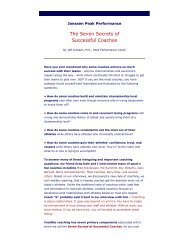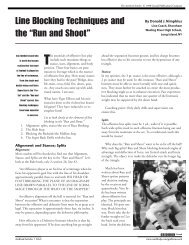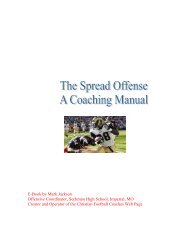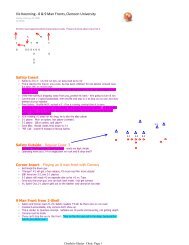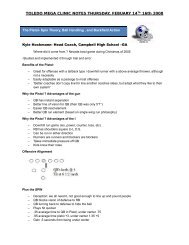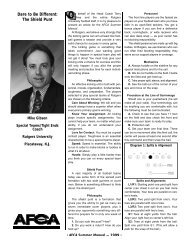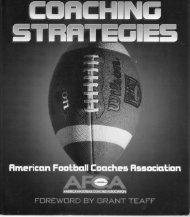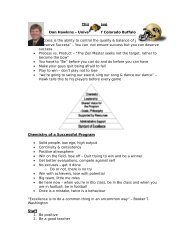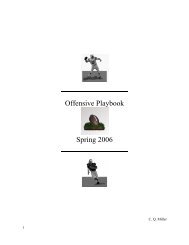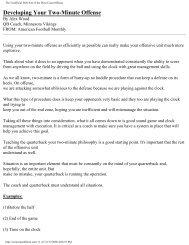Applying Pressure with the Zone Blitz - Fast and Furious Football
Applying Pressure with the Zone Blitz - Fast and Furious Football
Applying Pressure with the Zone Blitz - Fast and Furious Football
Create successful ePaper yourself
Turn your PDF publications into a flip-book with our unique Google optimized e-Paper software.
<strong>Applying</strong> <strong>Pressure</strong> <strong>with</strong><br />
<strong>the</strong> <strong>Zone</strong> <strong>Blitz</strong><br />
Chris Ash<br />
Defensive Coordinator<br />
Drake University<br />
Des Moines, Iowa<br />
It is truly a pleasure <strong>and</strong> an honor to be<br />
able to represent Drake University in <strong>the</strong><br />
AFCA Summer Manual. On behalf of our<br />
head coach Rob Ash <strong>and</strong> our defensive<br />
s t a ff — Defensive line coaches Roc<br />
Bellantoni <strong>and</strong> Paul Davis, linebacker<br />
coaches George Sypnewski <strong>and</strong> Dan<br />
Sullivan — we appreciate <strong>the</strong> opportunity<br />
to share some of our ideas <strong>and</strong> hope that<br />
<strong>the</strong>y can be of some benefit to you.<br />
When a certain scheme starts to enjoy<br />
some success, you can be assured that<br />
many teams will soon be running some<br />
variation of it. The zone blitz is definitely an<br />
example of this. Virtually every football<br />
team at <strong>the</strong> pro <strong>and</strong> college level, is running<br />
some form of zone blitz. At Drake,<br />
zone blitzes have become a vital <strong>and</strong> very<br />
successful component of our defensive<br />
package. This article will briefly discuss<br />
why we run zone blitzes <strong>and</strong> examine a few<br />
of our favorite ones.<br />
Before getting into our zone blitz<br />
schemes, I would first like to share our<br />
defensive philosophy. There are 10 important<br />
points to our philosophy.<br />
Drake Defensive Philosophy<br />
1. The best defensive teams are great<br />
because of <strong>the</strong>ir ability to stop <strong>the</strong> run first.<br />
We want to put <strong>the</strong> offense in predictable<br />
situations.<br />
2. To stop <strong>the</strong> run, we must put <strong>the</strong> best<br />
11 defensive players on <strong>the</strong> field.<br />
3. We want to be known for being relentless.<br />
When <strong>the</strong> ball is snapped, we are<br />
going to have 11 players flying as hard as<br />
<strong>the</strong>y can to <strong>the</strong> football.<br />
4. Look complicated, but be simple <strong>with</strong><br />
technique, alignment <strong>and</strong> assignment. This<br />
simplicity will lead to aggressiveness.<br />
5. <strong>Pressure</strong> <strong>and</strong> attack <strong>the</strong> offense. To<br />
do that we must be able to:<br />
A. Stem our fronts.<br />
B. Disguise our coverages.<br />
C. <strong>Blitz</strong> <strong>the</strong> quarterback.<br />
6. Stress “three-<strong>and</strong>-out” series <strong>and</strong> getting<br />
off <strong>the</strong> field quickly. Most big plays happen<br />
when <strong>the</strong> defense is tired.<br />
7. We must control <strong>the</strong> sudden change<br />
situation. Do not give up a touchdown in a<br />
sudden change situation.<br />
8. Create turnovers. Force takeaways<br />
through emphasis.<br />
9. We want to develop a “win every play”<br />
mentality. If <strong>the</strong> defense loses one play, we<br />
may lose <strong>the</strong> game.<br />
10. Play <strong>with</strong> excitement, enthusiasm,<br />
effort, <strong>and</strong> enjoy playing <strong>the</strong> game.<br />
• AFCA Summer Manual — 1999 •<br />
What is a <strong>Zone</strong> <strong>Blitz</strong><br />
The term zone blitz refers to bringing an<br />
extra rusher <strong>and</strong> playing some form of zone<br />
coverage behind it. At Drake, we have a<br />
number of different ways to get an extra<br />
rusher. One way is to simply vacate an<br />
underneath zone by bringing one of our<br />
linebackers <strong>and</strong> not drop anyone. Some of<br />
our zone blitzes require us to bring two<br />
linebackers <strong>and</strong> drop one defensive lineman.<br />
We also have zone blitzes that bring<br />
two linebackers <strong>and</strong> drop two defensive<br />
linemen.<br />
Why Do We Run <strong>Zone</strong> <strong>Blitz</strong>es<br />
In being an attacking pressure defense,<br />
we use a variety of five <strong>and</strong> six-man pressures,<br />
playing man free <strong>and</strong> straight man<br />
behind <strong>the</strong>m. If we do not blitz, we often<br />
show blitz <strong>and</strong> play different combinations of<br />
man <strong>and</strong> zone coverages. We think by running<br />
zone blitzes, that we combine some of<br />
<strong>the</strong> best elements of both, blitz <strong>and</strong> zone<br />
concepts, while at <strong>the</strong> same time creating<br />
confusion <strong>and</strong> indecision for <strong>the</strong> offense.<br />
By showing <strong>the</strong> same pre-snap look <strong>and</strong><br />
changing up between man <strong>and</strong> zone pressure,<br />
it makes it tough for <strong>the</strong> quarterback<br />
to get any kind of a pre-snap read at <strong>the</strong><br />
line of scrimmage. We give a pressure look<br />
<strong>with</strong> man coverage as much as possible.<br />
When we run a zone blitz, <strong>the</strong> defender is<br />
falling off <strong>and</strong> passing <strong>the</strong> receiver to<br />
ano<strong>the</strong>r defender. This creates confusion<br />
<strong>and</strong> makes it difficult for <strong>the</strong> quarterback to<br />
decide where he is going to throw <strong>the</strong> ball.<br />
We will play <strong>with</strong> our corners up in <strong>the</strong> face<br />
of <strong>the</strong> wide receivers, <strong>and</strong> play ei<strong>the</strong>r press<br />
man or bail <strong>the</strong>m to a deep third to fur<strong>the</strong>r<br />
add to <strong>the</strong> confusion.<br />
Along <strong>with</strong> confusion for <strong>the</strong> quarterback,<br />
zone blitzes add confusion for <strong>the</strong><br />
o ffensive line as well. Keeping off e n s i v e<br />
linemen on <strong>the</strong>ir heels by guessing whe<strong>the</strong>r<br />
<strong>the</strong>ir man is going to rush or drop leads<br />
<strong>the</strong>m to play tentatively. Once we get <strong>the</strong><br />
o ffensive linemen to play in a passive<br />
mode, we feel it really benefits our normal<br />
four-man pass rush.<br />
With our philosophy of being an attacking<br />
pressure defense, we rely heavily on<br />
our secondary’s ability to play man coverage.<br />
Even though this has been good to us,<br />
it does put a lot of pressure on <strong>the</strong> defensive<br />
backs. The zone blitz gives us a safe<br />
<strong>and</strong> effective way to still put pressure on<br />
<strong>the</strong> quarterback, but remove some of <strong>the</strong><br />
stress put on <strong>the</strong> defensive backs when<br />
playing man coverage.
We use pressure to try to dictate <strong>and</strong><br />
limit what an offense can do. By being able<br />
to create confusion, we hopefully can force<br />
an offense to commit a significant amount<br />
of practice time to preparation for our wide<br />
variety of man <strong>and</strong> zone blitzes. This takes<br />
practice time away from things that <strong>the</strong>y<br />
want to do offensively.<br />
Once you have success putting pressure<br />
on <strong>the</strong> quarterback, offenses start going to<br />
maximum protection. They will keep <strong>the</strong>ir<br />
backs <strong>and</strong> potentially <strong>the</strong>ir tight end in for<br />
extra pass protection. Now, instead of getting<br />
four or five receivers out into pass patterns,<br />
we will start to see more two <strong>and</strong> three-man<br />
routes. By using zone blitzes, we can put<br />
pressure on <strong>the</strong> quarterback, plus have maximum<br />
coverage versus limited receivers.<br />
Ano<strong>the</strong>r thing that we have discovered<br />
about zone blitzes is that our players have<br />
fun running <strong>the</strong>m. Our linebackers are<br />
always wanting to blitz, <strong>and</strong> our defensive<br />
linemen dream about having <strong>the</strong> opportunity<br />
to get an interception or getting a big hit<br />
on a receiver while in pass coverage. <strong>Zone</strong><br />
blitzes give us something that our players<br />
really enjoy doing <strong>and</strong> have a lot of fun<br />
preparing to run each week.<br />
How Do We Run <strong>Zone</strong> <strong>Blitz</strong>es<br />
We base our zone blitzes out of our 4-3<br />
<strong>and</strong> eagle fronts. We have <strong>the</strong> ability to get<br />
an extra rusher by bringing one or two linebackers<br />
<strong>and</strong> dropping one or two defensive<br />
linemen, depending on <strong>the</strong> blitz.<br />
Diagram 1: 4-3 Front<br />
dropping a safety into <strong>the</strong> underneath hole<br />
area. As a change-up, we will run zone<br />
blitzes from a two-deep look.<br />
Diagram 3: Cover Three Strong<br />
Diagram 4: Cover Three Weak<br />
Diagram 5: Three-Robber<br />
Diagram 6: Two-Deep<br />
Diagram 7: Eagle Storm Cover Three<br />
check for run first. On his drop, he reads<br />
from No. 2 to No. 1. He is a seam to flat<br />
dropper.<br />
Sam: <strong>Blitz</strong>es D gap. Is a contain player.<br />
Mike: <strong>Blitz</strong>es strong side B gap.<br />
Scrapes tight off of <strong>the</strong> b<strong>and</strong>it going inside<br />
to <strong>the</strong> A gap.<br />
Will: Key is No. 3. Is a B gap player <strong>with</strong><br />
run at him. Plays strong A gap <strong>with</strong> run<br />
away. He is <strong>the</strong> hole player vs. pass.<br />
Rover: Drops seam to flat strong. He<br />
reads No. 2 to No. 1.<br />
Free: Rotates to <strong>the</strong> deep middle third.<br />
Corner: Bail to deep outside third.<br />
The next blitz we will look at is run out of<br />
our eagle G front <strong>and</strong> we call it eagle G<br />
flush. In this blitz, we are going to bring our<br />
Mike <strong>and</strong> Will linebackers <strong>and</strong> drop our<br />
weak side defensive end. Behind our flush<br />
blitz we will drop our free safety into <strong>the</strong><br />
underneath hole <strong>and</strong> play our three-robber<br />
coverage.<br />
Diagram 8: Eagle G Flush<br />
Three Robber<br />
Diagram 2: Eagle Front<br />
Behind our zone blitzes, we will primarily<br />
play some form of three-deep. We can<br />
roll to cover three strong, cover three weak,<br />
or play what we call three robber, which is<br />
The first blitz we will look at is run out of<br />
our eagle front <strong>and</strong> called eagle storm. In<br />
eagle storm, we will blitz our Sam <strong>and</strong> Mike<br />
linebackers <strong>and</strong> drop our weak side defensive<br />
end. Behind it, we will play cover three<br />
to <strong>the</strong> strong side of <strong>the</strong> formation.<br />
Responsibilities<br />
B<strong>and</strong>it: Rip inside <strong>and</strong> attack <strong>the</strong><br />
guard’s outside shoulder. We want him to<br />
take <strong>the</strong> A gap by crushing <strong>the</strong> guard inside<br />
<strong>and</strong> <strong>the</strong>n working vertically upfield.<br />
Nose: Cross face on <strong>the</strong> center into <strong>the</strong><br />
weak A gap.<br />
Tackle: Contain player.<br />
E n d : Attack <strong>the</strong> offensive tackle to<br />
• AFCA Summer Manual — 1999 •<br />
Responsibilities<br />
B<strong>and</strong>it: Contain player.<br />
Nose: Cross face of <strong>the</strong> guard into <strong>the</strong><br />
strong B gap.<br />
Tackle: Contain player.<br />
E n d : Attack <strong>the</strong> offensive tackle to<br />
check for run first. On drop, read from No.<br />
2 to No. 1. He is a seam-to-flat dropper.<br />
Sam: Attack <strong>the</strong> tight end to check for<br />
run first. On his drop, he will read from No.<br />
2 to No. 1. He is a seam to flat dropper.<br />
Mike: <strong>Blitz</strong> weak A gap. Come tight<br />
behind <strong>the</strong> Will blitzing.<br />
Will: <strong>Blitz</strong> strong A gap.<br />
Rover: Rotate to <strong>the</strong> deep middle third.<br />
Free: Drop into <strong>the</strong> underneath hole.
Corner: Bail to deep outside third.<br />
The third <strong>and</strong> final zone blitz we will look<br />
at is called stack whip. It is run out of our<br />
stack front. In this blitz we will bring our Wi l l<br />
<strong>and</strong> Mike linebackers <strong>and</strong> drop our strong<br />
side defensive end. Behind it we will roll<br />
Cover 3 to <strong>the</strong> weak side of <strong>the</strong> formation.<br />
Diagram 9: Stack Whip Cover Three<br />
Responsibilities<br />
B<strong>and</strong>it: Attack <strong>the</strong> tight end to check for<br />
run first. On <strong>the</strong> drop, he will read No. 2 to<br />
No. 1. He is a seam to flat player.<br />
Tackle: Contain player.<br />
Nose: Cross face of center into strong A<br />
gap.<br />
End: Rip inside <strong>and</strong> attack <strong>the</strong> guard’s<br />
outside shoulder. We want him to take <strong>the</strong><br />
A gap by crushing <strong>the</strong> guard inside <strong>and</strong><br />
<strong>the</strong>n working vertically upfield.<br />
Sam: Hole player. Read No. 3. Run to,<br />
play B gap.<br />
Mike: <strong>Blitz</strong> weak B gap. Scrape tight off<br />
of <strong>the</strong> defensive end going into <strong>the</strong> A gap.<br />
Will: <strong>Blitz</strong> C gap. Contain player.<br />
Rover: Rotate to <strong>the</strong> deep middle third.<br />
The Drake defense held it’s opponents to less than 300 yards in total offense<br />
last season <strong>and</strong> was a big reason for <strong>the</strong> Bulldogs earning <strong>the</strong>ir second Pioneer<br />
<strong>Football</strong> League championship.<br />
Free: Drop <strong>and</strong> become a seam to flat<br />
player weak. Read No. 2 to No. 1.<br />
Corner: Bail to deep outside third.<br />
We have had some success <strong>with</strong> our pressure<br />
package by incorporating <strong>the</strong> zone blitz.<br />
Last season, we had a total of 36 sacks <strong>and</strong><br />
18 interceptions in 10 games. We believe in<br />
<strong>the</strong> aggressive, attacking style of defense. Our<br />
players <strong>and</strong> coaches believe in our system<br />
<strong>and</strong> are committed to preparing it each week.<br />
Again, on behalf of our head coach Rob<br />
Ash <strong>and</strong> <strong>the</strong> rest of <strong>the</strong> Drake University<br />
football program, we would like to thank <strong>the</strong><br />
A F C Afor <strong>the</strong> opportunity to contribute to this<br />
y e a r’s Summer Manual. I would also like to<br />
thank all of those coaches who, through <strong>the</strong><br />
years, have helped us grow in this profession.<br />
We hope this article can be of some<br />
benefit to your program, <strong>and</strong> wish you <strong>the</strong><br />
best of luck in <strong>the</strong> 1999 season.<br />
NCAA Position<br />
on Gambling<br />
The NCAA opposes all forms of legal <strong>and</strong> illegal sports wagering. Sports wagering has<br />
<strong>the</strong> potential to undermine <strong>the</strong> integrity of sports contests <strong>and</strong> jeopardizes <strong>the</strong> welfare<br />
of student-athletes <strong>and</strong> <strong>the</strong> intercollegiate athletics community. Sports wagering<br />
demeans <strong>the</strong> competition <strong>and</strong> competitors alike by a message that is contrary to <strong>the</strong><br />
purposes <strong>and</strong> meaning of ‘sport.’ Sports competition should be appreciated for <strong>the</strong><br />
inherent benefits related to participation of student-athletes, coaches <strong>and</strong> institutions<br />
in fair contests, not <strong>the</strong> amount of money wagered on <strong>the</strong> outcome of <strong>the</strong> competition.<br />
For those reasons, <strong>the</strong> NCAA membership has adopted specific rules prohibiting athletics<br />
department staff members <strong>and</strong> student-athletes from engaging in gambling activities<br />
as <strong>the</strong>y relate to intercollegiate or professional sporting events.<br />
• AFCA Summer Manual — 1999 •



